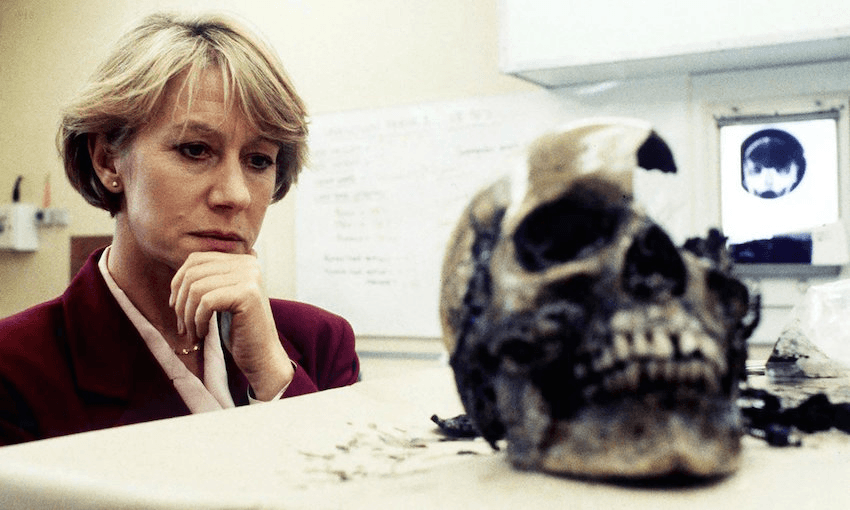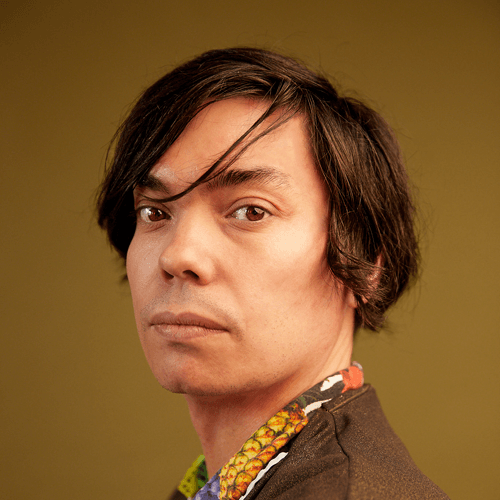All seven seasons of Prime Suspect drop on Lightbox today, and Sam Brooks is here to tell you why its central character Jane Tennison (Helen Mirren) is one of television’s most significant characters – ever.
Detective Chief Inspector Jane Tennison doesn’t show up until five minutes into the first episode of Prime Suspect, which came out way back in 1991. Before that, a series of male cops casually chat over the bruised and battered body of a woman who has been murdered, showing their cavalier and casual attitude to this woman, and their own jobs. These men don’t need to take things seriously, they just need to get the job done, because this is one crime among many.
When we do see Jane Tennison, played by Helen Mirren, she’s in a women’s bathroom being talked to by another woman. You get a sense that she’s cavalier and casual too, but in a different sense. This is a woman who doesn’t approach her job that way, that’s just how she approaches her life. She moves from this bathroom, what feels like a safe space, into an elevator. The elevator is immediately occupied and taken over by a bunch of faceless (and because this is British television, gormless) men who barely acknowledge her existence. She’s just taking up space in an elevator.
The elevator gets to her floor, and she has to push past them aggressively and say, “Excuse me!” to get out. They chuckle at her as she leaves – to them, she’s a silly woman who got uppity about nothing. To her, they’re the obstacle she’s going to have to deal with her entire career. To them, she’s always going to be the woman in the room taking up space that they think should be filled by a man.
This not tremendously subtle but pretty effective scene sums up Jane Tennison, and her struggles for the next six seasons of Prime Suspect. There’s always going to be a man there to question her credibility, her authority and her worthiness in her life.
It’s not a particularly revolutionary take now; there are thankfully countless shows that examine the role of women in the workplace and in society, and we’re richer for each one. Even back in 1991, Prime Suspect wasn’t unique – it came a full ten years after Cagney and Lacey, and a full 20 years after The Mary Tyler Moore Show – but the ways in which Prime Suspect would explore, darken and broaden Jane Tennison’s character were unique, and remains so even after its debut.
A huge asset for Prime Suspect is that it had 17 years to do that work. Essentially a series of mini-series, the show would take a few years off in between seasons, allowing Tennison to age, society to move forward, and for the entire television medium to move forward stylistically. The first season of Prime Suspect looks every inch a British television movie, all grainy greys and muddy browns, while the seventh season is essentially a feature film, going full film noir at times.
It means that Jane Tennison grew from a woman in her forties struggling to make her mark in the police force to a woman in her sixties trying to stay relevant in a profession that absolutely doesn’t want an older woman hanging around telling them what to do. It also gives Tennison, and Prime Suspect, the chance to tackle a surprisingly wide range of issues, especially for a show that has less than 20 episodes all up. The show tackles sexism (obviously), paedophilia, homophobia, racism in the police force, in surprisingly progressive and even-handed ways for a show that had every right to go stale and rest on the laurels of its lead performer.
And what a performer! For my money, this is Helen Mirren’s best work and crowning achievement (even more so than The Queen, and only slightly more so than her work in The Fate of the Furious). And admittedly, she’s been set up for it – how often does an actor get to have multiple cracks at a character at different stages in her development? – but it’s the little specificities that Mirren puts into Tennison that makes it a truly special performance.
It would’ve been easy to play Tennison as a ball-buster or as someone who robbed herself of her femininity to make it in a male-driven workplace. But we’ve seen that character before and while it’d be a valid take on the character, it’s so much more interesting to see the ways in which Mirren plays up Tennison’s femininity. Her soft voice, the compassion she shows to other women, her vulnerability when she’s off-duty – all of that makes her more complex. Tennison’s femaleness is a core aspect of her character, and Mirren reminds us of that constantly.
Even more beautifully, and crucially, Prime Suspect never treated Tennison as infallible. Right from the first episode, she messes up. She makes mistakes. As the series goes on, we see Tennison deal with her demons, from a refusal to deal with the death of her father in any appropriate way to seeing her ignore, and then finally deal with, her alcoholism. She is as flawed as any of us and both Prime Suspect and Mirren are so careful not to make her a representation or symbol of anything.
It would be a overstatement to say that Jane Tennison changed the way we view women on television, but she’s definitely one of the bricks thrown at the wall that is the misrepresentation and underrepresentation of women on television. Prime Suspect is a good and often great police procedural – and has aged a lot better than many dramas from the 90s – but what makes it an absolutely essential piece of television is Jane Tennison. Like all of us, she’s always fighting, always struggling against something, and it’s rarely felt more real or more human than when it’s Jane doing the fighting.
You can watch all seven seasons of Prime Suspect right here:





